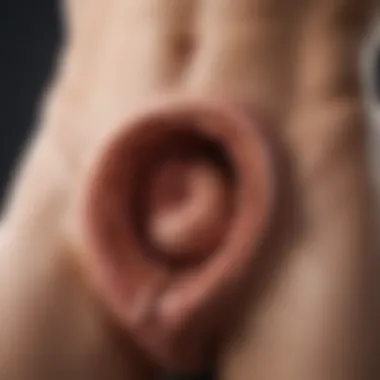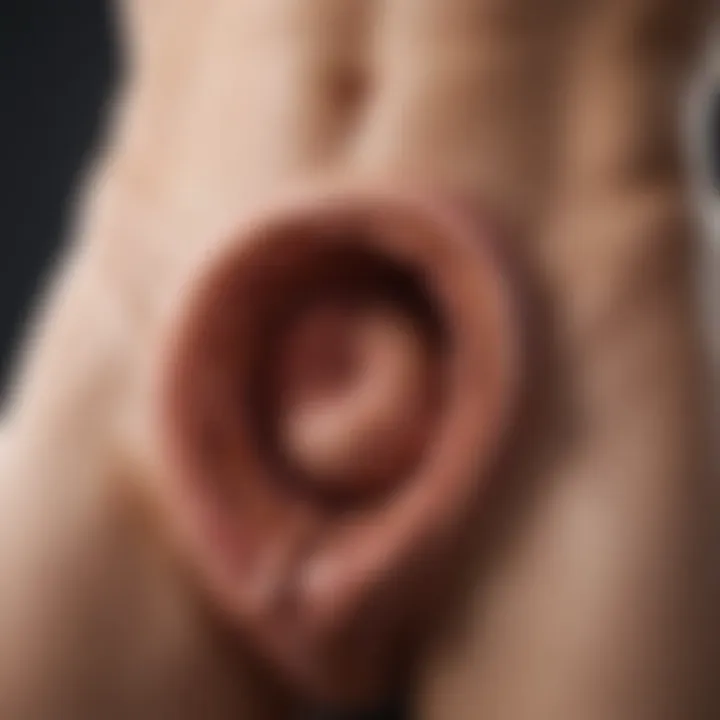Understanding the Urge to Pee with Minimal Output


Intro
Experiencing a strong urge to urinate accompanied by minimal output can be both perplexing and unsettling. This sensation, while common, can often leave individuals feeling confused about their urinary health. Understanding this phenomenon involves exploring various physiological and psychological factors that contribute to it.
As we delve into this topic, we will uncover potential causes, diagnostic methods, and effective management strategies. The aim is to provide a well-rounded understanding for those who might find themselves grappling with this distressing sensation.
Key Benefits
Addressing the underlying causes of frequent urges to urinate is crucial not only for physical health but also for mental well-being. Broadly speaking, there are two key areas to consider.
Physical Health Benefits
- Improved Urinary Function: By identifying and managing the causes of frequent urges, individuals may experience better urinary control. This can lead to a significant improvement in overall comfort.
- Reduced Discomfort: Understanding the reasons behind these urges can lessen anxiety, reducing the discomfort associated with constant urgency.
- Better Hydration Status: Proper management can guide individuals towards optimal hydration practices, aligning fluid intake with bodily needs and function.
Mental Well-being Enhancements
- Anxiety Reduction: Knowledge and understanding can greatly reduce anxiety surrounding sudden urges, promoting a more relaxed mental state.
- Empowerment: Gaining insights into urinary health encourages individuals to take proactive measures, fostering a sense of control over their health.
- Connection to Overall Health: Urinary symptoms can often relate to broader health issues. By addressing these problems, one may gain a deeper understanding of their overall health, enhancing their well-being.
Understanding the factors contributing to a strong urge to urinate can lead to improved health outcomes.
Practical Tips
Engaging in effective management strategies can alleviate the distress linked to frequent urges and improve overall urinary health. Here are some practical recommendations:
Effective Meal Planning
- Hydration Monitoring: Keep a journal of fluid intake to identify patterns. Adjust accordingly.
- Dietary Adjustments: Avoid excessive caffeine and artificial sweeteners, as they may irritate the bladder.
- High Fiber Foods: Incorporate high-fiber foods to promote digestive regularity and overall health.
Quick and Efficient Workouts
- Kegel Exercises: These can strengthen pelvic floor muscles and potentially reduce urgency.
- Yoga: Incorporating gentle yoga can relieve tension that may contribute to urgency.
Prelims
The experience of a strong urge to urinate that is accompanied by minimal output is a prevalent yet often misunderstood phenomenon. This topic is crucial for several reasons. First, it touches on the basic aspect of human physiology and health. Everyone experiences urges to pee. However, when the sensation does not lead to a satisfactory result, it can cause discomfort and anxiety. Understanding the underlying reason for this sensation can aid in addressing potential health issues before they escalate.
Additionally, factors causing these urges can stem from benign to serious medical conditions. Knowing how to distinguish between ordinary occurrences and symptoms of a more significant concern is vital for prompt intervention. This article aims to illuminate the nuances surrounding urinary health, detailing its physiological and psychological dimensions.
By examining the causes, diagnostic methods, and management options, readers can gain insights that are not only informative but also empowering. As more individuals dive into their health journeys, clarity on urinary health can foster proactive habits and better decision-making in regards to their well-being.
Physiology of Urination
Understanding the physiology of urination is crucial for diagnosing and treating a strong urge to pee with minimal output. This section explores the normal functioning of the urinary system and highlights the key role of the bladder. By comprehending these elements, health professionals can better address patient concerns.
Normal Urinary Function
Normal urinary function is fundamental to maintaining bodily homeostasis. The process begins with filtration in the kidneys, where waste products are removed from the bloodstream. The filtered fluid, known as urine, then travels through the ureters and is stored in the bladder until excretion occurs.
Factors affecting urinary function include:
- Fluid intake: Adequate hydration influences urine production and concentration.
- Hormonal influences: Hormones like antidiuretic hormone regulate the balance of fluids in the body.
- Timing: The urge to urinate can be affected by fullness in the bladder, stretching receptors sending signals to the brain.
Understanding normal urinary function helps differentiate between physiological responses and pathological conditions leading to unusual sensations, such as a strong urge but with minimal output.
The Role of the Bladder
The bladder is a hollow muscular organ that stores urine until voluntary excretion. Its elasticity allows it to expand as it fills, which is essential for normal urinary function. The sensations experienced while filling—the urge to urinate—are mainly generated by stretch receptors in the bladder wall.
Key aspects of bladder function include:


- Storage capacity: A normal bladder can hold between 300 to 500 milliliters of urine.
- Neural control: The bladder’s contraction and relaxation are controlled by the autonomic nervous system.
- Voluntary control: The urge to void is both a physiological and neurological response that includes voluntary muscle contraction followed by the sphincter relaxation.
A well-functioning bladder is vital for maintaining a healthy urinary system. Disruptions in its normal functioning can lead to issues like urgency without adequate output. Understanding bladder physiology allows for better management of symptoms and contributes to a comprehensive approach to urinary health.
Common Causes of Strong Urge with Little Output
The sensation of a strong urge to urinate accompanied by minimal output can be troubling for many individuals. Understanding the common causes of this phenomenon is essential for both health professionals and those seeking insight into their urinary health. By identifying these causes, one can better approach diagnosis and treatment, creating a clearer path toward relief.
Infection and Inflammation
Infections of the urinary tract are one of the main contributors to strong urges alongside reduced output. When bacteria invade the bladder, they can irritate the lining, causing an overwhelming sensation to urinate. Inflammation leads to alterations in bladder function, heightening the urgency felt by the individual. Conditions like cystitis, caused by either bacterial or viral infection, are typical examples.
Key points include:
- Symptoms: Individuals may also experience burning during urination and cloudy urine.
- Diagnosis: A urinalysis can confirm the presence of infection.
- Treatment: Antibiotics are often the course of action for bacterial infections.
Neurological Disorders
Neurological disorders present another layer of complexity concerning urinary urgency. Disorders such as multiple sclerosis or Parkinson’s disease can disrupt communication between the brain and bladder. This disconnection may lead to misinterpretation of signals, resulting in frequent urges even when urine volume is low. Recognizing these underlying conditions is vital for appropriate management.
Considerations include:
- Patient history: Often, a thorough medical history can reveal previous diagnoses.
- Management may involve specialized therapies to improve bladder control.
Obstructive Conditions
Obstructive conditions in the urinary tract also play a significant role. For instance, benign prostatic hyperplasia can cause increased pressure on the bladder, leading to a constant urge to urinate with limited ability to empty the bladder completely. Other blockages, such as strictures, can inhibit the flow of urine, manifesting similar symptoms. Identifying such obstructions is crucial for managing the urgency effectively.
Example aspects to evaluate:
- Physical examination: A prostate examination in males can provide insights.
- Ultrasound may help visualize any blockages.
Medications and Their Side Effects
Many medications have side effects that impact urinary function, leading to an urgent need to urinate with little output. Diuretics, commonly known as “water pills,” increase urine production but can paradoxically lead to a feeling of urgency without the corresponding output due to fluid imbalances. Other drugs may also affect bladder contractility or sensory perception, further complicating the situation.
Important points to remember:
- Review of medications: A complete list of current medications can help identify potential culprits.
- Consultation with a healthcare provider may be necessary to adjust medications if side effects are intolerable.
In summary, understanding the common causes of a strong urge to urinate with minimal output is crucial for both diagnosis and effective management. Each cause presents unique considerations and potential treatments that contribute to an informed approach in handling this distressing sensation.
Psychological Factors
Understanding the psychological factors that influence a strong urge to urinate with minimal output is crucial. This aspect can often be overlooked when assessing urinary health. Psychological wellness plays a fundamental role in physical health, affecting bodily functions in various ways. The connection between anxiety and urinary urgency is particularly significant. Individuals experiencing high levels of anxiety might notice increased frequency and urgency of urination, often without corresponding output. Recognizing this tie between mind and bladder function is essential in the diagnosing and managing of such symptoms.
Anxiety and Urgency
Anxiety can create many physical symptoms, and urinary urgency is one of them. When a person feels anxious, the body's fight-or-flight response can kick in, stimulating a reaction that affects the bladder. This reaction may cause the bladder muscles to contract, leading to a feeling of urgency even if the bladder isn't full. Studies show that individuals with anxiety disorders often report urinary frequency as a symptom.
- Common causes of anxiety-related urinary urgency include:
- Panic attacks
- Generalized Anxiety Disorder
- Social Anxiety
Coping strategies and behavioral therapies can significantly help reduce urgency linked to anxiety. Mindfulness and relaxation techniques are especially effective, allowing individuals to manage anxiety levels and, in turn, alleviate the overwhelming need to urinate.
Impact of Stress
Stress is another psychological element that can exacerbate urinary urgency. When under stress, the body produces more hormones like cortisol, which can influence the nervous system and lead to increases in urinary frequency. It is important to understand that stress does not only affect mental wellness; it also has direct physical implications. Some individuals may not connect their stressful situations with their body’s reactions, like frequent urges to urinate.


"Understanding the relationship between stress and urinary health can provide vital insights leading to better coping mechanisms."
To mitigate the effects of stress on urination, several methods can be applied:
- Balanced diet and hydration: What we consume affects overall health and well-being, including stress levels.
- Regular exercise: Physical activity has proven benefits for reducing stress and anxiety.
- Adequate sleep: Poor sleep can amplify stress, leading to an ongoing cycle that may worsen urinary urgency.
Diagnostic Approaches
Understanding the strong urge to urinate with minimal output involves various diagnostic approaches. These methods help healthcare professionals determine the underlying causes and tailor treatment plans appropriately. A comprehensive evaluation is essential, as it provides clarity on the issue and paves the way for effective management strategies.
Clinical Assessment
Clinical assessment forms the foundation of diagnosing urinary issues. It typically begins with a detailed history of the patient's symptoms. This includes the frequency of urges, any accompanying pain, and recent changes in urinary patterns.
Doctors will often ask about lifestyle factors, including fluid intake, diet, and exercise. This information is crucial because it can point to factors that may contribute to the urge, such as dehydration or irritants in the diet like caffeine or alcohol.
The physical examination is also important. Through palpation of the lower abdomen, a doctor can assess bladder distension. Signs of discomfort or unusual tenderness in the bladder area could indicate an underlying issue. Any noted abnormalities can guide subsequent diagnostics.
Laboratory Tests
Laboratory tests are vital for confirming or ruling out specific medical conditions. A urinalysis is often the first step, where a sample of urine is analyzed for signs of infection, blood, or other abnormalities. This can reveal conditions like urinary tract infections or kidney stones, both of which can cause strong urges with limited output.
Additionally, blood tests may be performed to evaluate kidney function and check for other issues that might affect urination. For example, elevated creatinine levels could indicate renal impairment, while signs of inflammation or infection could emerge through blood counts.
Imaging Studies
Imaging studies provide more detailed insights into the urinary system's physical structure. Ultrasounds are commonly used to examine the bladder and kidneys, checking for abnormalities such as stones or tumors. This non-invasive procedure allows for a clear view of the urinary tract without exposing patients to radiation.
In some cases, a CT scan or MRI may be warranted for a more comprehensive analysis. These advanced imaging techniques can reveal issues that may not be visible on standard tests, such as blockages or structural abnormalities.
In summary, employing a combination of clinical assessment, laboratory tests, and imaging studies equips healthcare providers with a robust framework for diagnosing the strong urge to urinate with minimal output.
By thoroughly investigating these aspects, appropriate treatments can be recommended to alleviate the symptoms and address any underlying health concerns.
Management Strategies
Effective management strategies are essential for individuals experiencing the strong urge to urinate with minimal output. This sensation can affect one's quality of life, and understanding effective approaches can help manage symptoms effectively. There are many options to consider, each addressing different aspects of the problem. This section will explore lifestyle modifications, pharmacological interventions, and surgical options, providing a comprehensive overview of available strategies.
Lifestyle Modifications
Lifestyle changes can significantly impact urinary health. Making small adjustments can help in regulating bladder function and reducing urgency. Here are some strategies:
- Hydration Balance: Maintaining proper hydration is crucial. Drinking an adequate amount of fluids helps prevent concentrated urine, which can irritate the bladder.
- Diet Adjustments: Some foods and beverages may trigger bladder irritation. Caffeine, alcohol, and spicy foods, for example, can increase urgency. Adjusting the diet accordingly can reduce these symptoms.
- Scheduled Toilet Visits: Implementing a regular toileting schedule can train the bladder. This practice encourages urination at set times, minimizing unexpected urges.
- Pelvic Floor Exercises: Strengthening pelvic floor muscles can enhance bladder control. Kegel exercises, in particular, are beneficial for both men and women.
These lifestyle modifications can provide individuals with more control over their urinary habits, improving their overall experience.
Pharmacological Interventions
Medication may be necessary for those who do not find relief through lifestyle changes. Various pharmacological options exist, each targeting specific symptoms or underlying issues. It is essential to consult a healthcare provider to determine the best approach. Here are some commonly prescribed medications:
- Anticholinergics: These drugs help reduce bladder spasms and can diminish urgency. Medications like oxybutynin and tolterodine are frequently used for this purpose.
- Beta-3 Agonists: This class of medications promotes relaxation of the bladder muscle. Mirabegron is a notable example, addressing overactive bladder symptoms effectively.
- Topical Estrogen: For postmenopausal women, localized estrogen therapy may improve urinary symptoms by enhancing bladder elasticity.
Pharmacological options may not provide immediate relief and can have side effects, therefore careful monitoring is necessary.
Surgical Options
In some cases, surgical interventions may be warranted, especially if structural issues contribute to urinary difficulties. Surgical options vary widely based on individual circumstances and underlying causes. Here are a few examples of surgical interventions:
- Sling Procedures: These surgeries involve placing a mesh device under the urethra to provide support, which can alleviate urgency and incontinence issues.
- Bladder Augmentation: This procedure enlarges the bladder to increase its capacity. It may be recommended for individuals with serious bladder dysfunction.
- Neurostimulation Devices: Utilizing electrical impulses, these devices can help regulate bladder function. They work by stimulating nerves that control the bladder and may offer relief from urgency.
Surgical options generally carry more risks and often require thorough consideration and evaluation by healthcare specialists.


While each approach has its benefits and disadvantages, individuals experiencing urinary urgency should engage in detailed discussions with healthcare professionals for tailored advice.
By employing these management strategies, individuals can reclaim control over their urinary health, fostering improved well-being.
When to Seek Medical Advice
Understanding when to seek medical advice is crucial for anyone experiencing a strong urge to urinate with minimal output. This phenomenon can be both a source of discomfort and a signal of underlying health issues. Knowing when to act is an important part of maintaining urinary health. Certain symptoms may indicate a need for professional evaluation. Early intervention can often lead to better outcomes.
Recognizing Warning Signs
Recognizing specific warning signs associated with this condition is essential for appropriate action. Here are some indicators that suggest the need for medical attention:
- Persistent Urgency: If the urge to urinate occurs frequently and does not improve over time, this could be a sign of an underlying condition.
- Pain or Discomfort: Experiencing pain when attempting to urinate is often a warning sign that should not be ignored. This can indicate infections or other issues.
- Blood in Urine: The presence of blood in urine is a serious symptom that needs immediate medical evaluation.
- Fever or Chills: Accompanying symptoms such as fever may suggest an infection requiring urgent care.
- Changes in Urinary Pattern: Any significant changes in how often or how much urine is produced should be discussed with a healthcare provider.
Being observant about these symptoms can significantly influence the management of urinary health issues.
Consulting a Specialist
When it becomes clear that a pattern of strong urgency with little output is affecting daily life, consulting a specialist is a prudent step. Healthcare professionals can provide specialized insights and assessments. Here’s what a specialist can offer:
- Thorough Evaluation: Specialists, such as urologists, can perform comprehensive examinations to identify the root causes of symptoms.
- Targeted Tests: They may recommend specific tests tailored to the individual's reported symptoms, helping to clarify the diagnosis.
- Custom Treatment Plans: Based on the analysis, specialists can prescribe targeted treatment options that might include medication, therapy, or lifestyle changes.
- Follow-Up Care: Ongoing assessments ensure that any treatment is as effective as possible and can adjust to the patient’s needs over time.
Consulting a specialist not only aids in accurate diagnosis but also empowers individuals to reclaim their quality of life against the backdrop of urinary irregularities.
"Recognizing the right moments to consult a healthcare provider can lead to timely interventions and better health outcomes."
Preventative Measures
Preventative measures focus on reducing the occurrence of a strong urge to pee with minimal output. Understanding these measures is crucial for managing urinary health effectively. Implementing simple lifestyle changes can enhance one’s bladder function and overall well-being.
Maintaining Hydration
Maintaining adequate hydration is essential for urinary health. When the body is well-hydrated, urine production increases, helping to flush out toxins. Conversely, dehydration can lead to concentrated urine, causing irritation to the bladder. Therefore, it is recommended to drink sufficient water daily. However, individuals should also note not to overdo it, as excessive fluid intake may lead to increased urgency without more output.
Being conscious about fluid intake can also help in regulating the urge. Consuming water consistently throughout the day diminishes the likelihood of sudden, strong urges. Moreover, it is wise to avoid excessive caffeine or alcohol, as they can irritate the bladder and exacerbate urgency.
Consider tracking your hydration levels by observing the color of your urine. A pale yellow shade usually indicates proper hydration. While listening to your body’s cues is crucial, ensuring your hydration remains optimal plays a significant role in mitigating urinary issues.
Regular hydration aids in maintaining a healthy bladder and reduces irritation.
Regular Exercise and Its Benefits
Engaging in regular exercise has a multitude of benefits for overall health, including urinary health. Physical activity strengthens the pelvic floor muscles, which can greatly enhance bladder control. By doing exercises that target these muscles, individuals may notice a reduction in the frequency of urgency.
Moreover, regular exercise promotes better circulation and helps in managing stress levels. Stress can be a contributing factor to urgency in some individuals. By keeping stress in check through physical activity, one can also help regulate urinary urges.
Integrating forms of exercise such as walking, swimming, or yoga can be particularly beneficial. Each of these activities can contribute to a healthier body, potentially lessening the discomfort associated with urinary urgency. Here are some simple exercises to consider:
- Kegel exercises: Strengthen pelvic floor muscles.
- Yoga: Reduces stress and improves flexibility.
- Aerobic activities: Supports overall health and circulation.
Closure
In this article, we explored how different physiological and psychological factors can lead to this sensation. The relationship between bladder function and the brain’s perception of urgency is integral to this discussion. For healthcare professionals, recognizing the spectrum of possible causes is important for diagnosis and treatment. Understanding can lead to better outcomes, both in management and in patient quality of life.
Proactive health management is emphasized throughout as a way to mitigate discomfort and promote wellbeing. Taking the necessary steps to address urinary issues can result in better health overall.
Summarizing Key Insights
- The urge to urinate, particularly when accompanied by minimal output, can have multifactorial origins.
- Common factors include infections, neurological issues, and psychological stressors.
- Diagnostic approaches play a pivotal role in identifying specific causes and tailoring suitable treatment plans.
- Lifestyle modifications, medication, and in certain cases, surgical options, can offer relief.
- It is vital to recognize warning signs that warrant medical consultation.
Encouraging Proactive Health Management
Health management should be proactive, not reactive. Monitoring bodily signals can help individuals catch potential issues early. Here are a few tips to promote better urinary health:
- Stay hydrated but balance fluid intake based on individual needs.
- Incorporate regular physical activity into your daily routine to improve circulation and bladder function.
- Reduce caffeine and alcohol consumption, as these can irritate the bladder.
- Prioritize stress management techniques, which can alleviate urgency and anxiety.
- Consult professionals regularly for any persistent urinary issues to catch early signs of potential complications.
Understanding this physiological experience is crucial. Both self-awareness and medical insights can enhance quality of life, transforming discomfort into understanding and control.















